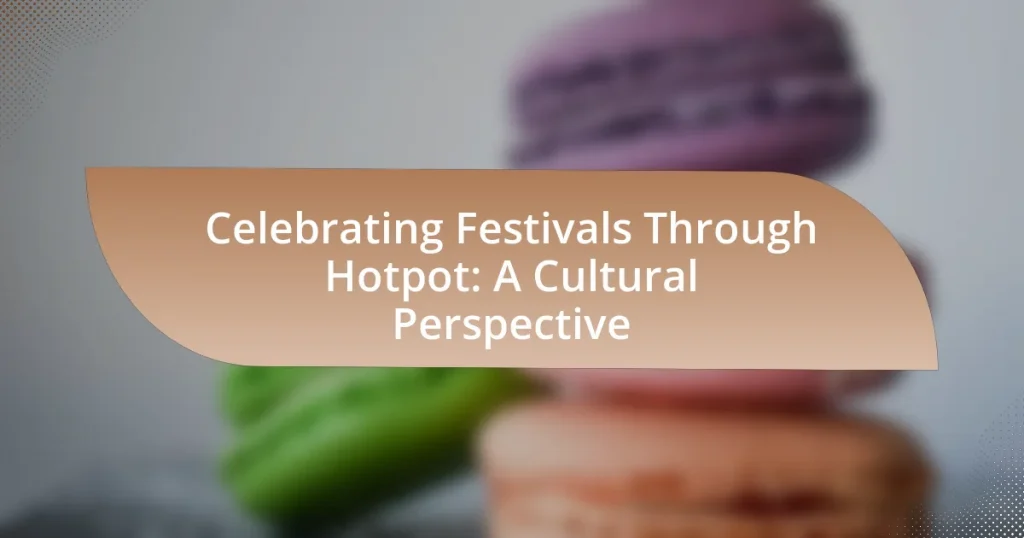Hotpot is a significant cultural practice during festival celebrations, symbolizing unity and togetherness among participants. This communal dining experience, prevalent in various cultures, particularly during events like the Lunar New Year and the Mid-Autumn Festival, emphasizes shared values and enhances social bonds. The article explores how hotpot reflects cultural traditions, the common ingredients used, regional variations, and the role of sharing food in fostering connections among family and friends. Additionally, it provides insights into best practices for hosting hotpot gatherings, including ingredient selection and creating a festive atmosphere, while highlighting common mistakes to avoid.

What is the significance of hotpot in festival celebrations?
Hotpot holds significant cultural importance in festival celebrations as it symbolizes unity and togetherness among participants. During festivals, families and friends gather around a communal pot, sharing a meal that fosters social bonds and enhances communal spirit. This practice is rooted in traditions where the act of cooking and eating together is seen as a way to strengthen relationships and celebrate harmony. For instance, in Chinese culture, hotpot is often enjoyed during Lunar New Year celebrations, where it represents prosperity and the warmth of family gatherings.
How does hotpot reflect cultural traditions during festivals?
Hotpot reflects cultural traditions during festivals by serving as a communal dining experience that emphasizes togetherness and shared values. This cooking method, often enjoyed during celebrations like Lunar New Year, symbolizes unity and family bonding, as participants gather around a simmering pot to cook and share various ingredients. The practice of hotpot also incorporates regional flavors and ingredients, showcasing local culinary heritage and customs, which further reinforces cultural identity during festive occasions. For instance, in China, the inclusion of specific ingredients like fish or dumplings during the New Year hotpot is believed to bring good fortune, illustrating how food traditions are intertwined with cultural beliefs and practices during celebrations.
What ingredients are commonly used in hotpot for festive occasions?
Common ingredients used in hotpot for festive occasions include thinly sliced meats, seafood, vegetables, and various dipping sauces. Thinly sliced beef, lamb, and pork are popular choices, as they cook quickly in the broth. Seafood options often feature shrimp, fish, and squid, adding a rich flavor to the dish. A variety of vegetables such as mushrooms, leafy greens, and root vegetables enhance the nutritional value and texture. Additionally, dipping sauces like sesame sauce, soy sauce, and chili oil are essential for flavor enhancement. These ingredients reflect cultural traditions and preferences, making hotpot a celebratory dish during festivals.
How do regional variations of hotpot enhance festival experiences?
Regional variations of hotpot enhance festival experiences by offering diverse flavors and cooking styles that reflect local traditions and ingredients. Each region’s unique hotpot recipe incorporates specific broths, meats, and vegetables, allowing festival-goers to engage with the cultural heritage of that area. For instance, Sichuan hotpot is known for its spicy broth and bold flavors, while Cantonese hotpot emphasizes fresh seafood and lighter tastes. This variety not only caters to different palates but also fosters a sense of community as people gather to share and celebrate these culinary traditions during festivals. The incorporation of local ingredients and cooking methods in hotpot serves as a tangible representation of regional identity, enriching the overall festival experience.
Why is hotpot considered a communal dining experience during festivals?
Hotpot is considered a communal dining experience during festivals because it encourages shared participation and interaction among diners. The nature of hotpot involves cooking various ingredients together in a shared pot, which fosters a sense of togetherness and collaboration. This communal aspect is particularly significant during festivals, where the act of gathering around a hotpot symbolizes unity and celebration among family and friends. Additionally, cultural traditions often emphasize the importance of sharing food during festive occasions, reinforcing the idea that hotpot is not just a meal but a social event that strengthens bonds and creates lasting memories.
What role does sharing food play in festival celebrations?
Sharing food plays a central role in festival celebrations by fostering community bonds and enhancing social interactions. During festivals, communal meals, such as hotpot, serve as a medium for people to gather, share stories, and strengthen relationships. This practice is rooted in cultural traditions where food symbolizes abundance and hospitality, reinforcing social ties. For instance, in many Asian cultures, sharing a hotpot meal during festivals signifies unity and collective joy, as participants contribute ingredients and partake in the cooking process together. This communal aspect not only enriches the celebratory experience but also reflects cultural values of togetherness and generosity.
How does hotpot foster connections among family and friends during festivals?
Hotpot fosters connections among family and friends during festivals by creating an interactive dining experience that encourages sharing and collaboration. The communal nature of hotpot allows participants to cook together, fostering communication and bonding as they select ingredients and share stories while waiting for their food to cook. This shared activity enhances social ties, as evidenced by cultural practices in regions like China, where hotpot is traditionally enjoyed during significant celebrations such as Lunar New Year, emphasizing unity and togetherness. The act of gathering around a hotpot symbolizes warmth and connection, reinforcing relationships among participants.

What are the different festivals celebrated with hotpot?
Different festivals celebrated with hotpot include Chinese New Year, where families gather to enjoy hotpot as a symbol of reunion and prosperity, and the Lantern Festival, which often features hotpot as part of the celebratory meal. Additionally, the Mid-Autumn Festival incorporates hotpot in family gatherings to celebrate harvest and unity. These festivals emphasize the communal aspect of hotpot dining, reinforcing cultural traditions and family bonds during significant occasions.
Which cultural festivals prominently feature hotpot?
Cultural festivals that prominently feature hotpot include the Chinese New Year and the Lantern Festival. During the Chinese New Year, families gather to enjoy hotpot as a symbol of reunion and prosperity, with various ingredients representing good fortune. The Lantern Festival, celebrated on the 15th day of the Lunar New Year, also incorporates hotpot as part of the festivities, emphasizing communal dining and the sharing of good wishes. These festivals highlight the significance of hotpot in fostering togetherness and cultural traditions.
How is hotpot integrated into Lunar New Year celebrations?
Hotpot is integrated into Lunar New Year celebrations as a communal dining experience that symbolizes unity and togetherness among family and friends. During this festive period, families gather around a hotpot to cook and share various ingredients, reflecting the importance of harmony and connection in Chinese culture. The act of sharing food from a communal pot is believed to bring good fortune and prosperity for the coming year, aligning with the traditional values associated with the Lunar New Year.
What unique hotpot traditions exist during Mid-Autumn Festival?
During the Mid-Autumn Festival, a unique hotpot tradition involves families gathering to share a communal meal featuring a variety of ingredients that symbolize reunion and harmony. This practice emphasizes the importance of togetherness, as families often prepare and cook the hotpot together, fostering a sense of unity. Additionally, certain regions incorporate mooncakes into the hotpot experience, blending traditional flavors and enhancing the festive atmosphere. This tradition reflects the cultural significance of the festival, which celebrates the harvest and the full moon, symbolizing completeness and family unity.
How do different cultures adapt hotpot for their festivals?
Different cultures adapt hotpot for their festivals by incorporating local ingredients, unique flavors, and traditional cooking methods that reflect their cultural heritage. For instance, in China, hotpot is often enjoyed during the Lunar New Year, featuring a variety of meats, vegetables, and dipping sauces that symbolize prosperity and good fortune. In Japan, during the New Year celebrations, a special type of hotpot called “sukiyaki” is prepared, using thinly sliced beef, tofu, and seasonal vegetables, emphasizing harmony and togetherness. Similarly, in Korea, the “jeongol” hotpot is popular during festive occasions, showcasing a mix of seafood, meat, and vegetables, often served with a spicy broth that represents the vibrant flavors of Korean cuisine. These adaptations not only highlight the diversity of hotpot but also reinforce the cultural significance of communal dining during celebrations.
What are some examples of international hotpot variations during celebrations?
International hotpot variations during celebrations include Chinese Sichuan hotpot, which is often enjoyed during Lunar New Year for its communal aspect and spicy flavors; Japanese shabu-shabu, typically served during family gatherings and New Year celebrations, emphasizing fresh ingredients; and Korean jeongol, a hearty stew enjoyed during holidays like Chuseok, featuring a variety of meats and vegetables. These variations reflect cultural significance, as they foster togetherness and symbolize prosperity and abundance during festive occasions.
How do local ingredients influence hotpot recipes in various festivals?
Local ingredients significantly influence hotpot recipes during various festivals by reflecting regional flavors and cultural traditions. For instance, in Sichuan, the use of local chili peppers and spices creates a distinctively spicy hotpot that aligns with the region’s culinary identity. Similarly, during the Lunar New Year, ingredients like fish and dumplings are incorporated into hotpot recipes to symbolize prosperity and good fortune, showcasing how local customs shape the dish. Festivals often highlight seasonal produce, such as mushrooms in autumn or fresh vegetables in spring, further emphasizing the connection between local agriculture and festive hotpot variations. This integration of local ingredients not only enhances the flavor profile but also fosters a sense of community and cultural heritage during celebrations.

What are the best practices for celebrating festivals with hotpot?
The best practices for celebrating festivals with hotpot include selecting a variety of fresh ingredients, ensuring a communal dining experience, and incorporating traditional recipes. Fresh ingredients such as meats, vegetables, and noodles enhance the flavor and quality of the hotpot, which is essential for a festive atmosphere. A communal dining experience fosters social interaction and bonding, as hotpot is traditionally enjoyed with family and friends gathered around a shared pot. Additionally, using traditional recipes or regional variations can honor cultural heritage and enhance the authenticity of the celebration. These practices not only elevate the dining experience but also create a sense of togetherness and cultural appreciation during festivals.
How can one prepare for a successful hotpot festival gathering?
To prepare for a successful hotpot festival gathering, one should plan the menu and gather fresh ingredients in advance. This includes selecting a variety of proteins, vegetables, and broths to cater to diverse tastes, as hotpot is traditionally a communal dish that encourages sharing and interaction. Research indicates that having a well-rounded selection enhances the dining experience, as it allows guests to customize their meals according to personal preferences. Additionally, ensuring that cooking equipment, such as portable stoves and pots, is ready and functional is crucial for a smooth gathering. Preparing dipping sauces and side dishes ahead of time can also elevate the overall experience, as these accompaniments are integral to the hotpot tradition.
What essential equipment is needed for a hotpot celebration?
A hotpot celebration requires essential equipment including a hotpot pot, a portable stove or induction cooker, and utensils such as chopsticks and ladles. The hotpot pot is specifically designed for cooking broth and ingredients simultaneously, while the portable stove provides the necessary heat source for cooking at the table. Utensils like chopsticks and ladles are crucial for serving and eating the food. This equipment is fundamental to the hotpot experience, ensuring that participants can enjoy the communal cooking and dining process effectively.
How can one select the best ingredients for a festive hotpot meal?
To select the best ingredients for a festive hotpot meal, prioritize fresh, high-quality items that cater to diverse tastes and dietary preferences. Fresh vegetables like bok choy, mushrooms, and leafy greens provide essential nutrients and vibrant flavors, while proteins such as thinly sliced beef, chicken, or tofu offer variety and satisfaction. Additionally, including a selection of noodles and dipping sauces enhances the overall experience. Research indicates that using seasonal ingredients not only improves taste but also supports local agriculture, making the meal more sustainable.
What tips can enhance the hotpot dining experience during festivals?
To enhance the hotpot dining experience during festivals, diners should focus on selecting a variety of fresh ingredients, including meats, vegetables, and noodles, to create a diverse and flavorful meal. This variety not only caters to different tastes but also encourages sharing and interaction among diners, which is essential during festive gatherings. Additionally, incorporating traditional dipping sauces and condiments can elevate the flavors and provide a more authentic experience. Research indicates that communal dining, such as hotpot, fosters social connections and enhances enjoyment, making it particularly suitable for celebrations.
How can one create a festive atmosphere for hotpot gatherings?
To create a festive atmosphere for hotpot gatherings, one should focus on vibrant decorations, engaging music, and a variety of fresh ingredients. Vibrant decorations, such as colorful tablecloths, lanterns, and themed centerpieces, enhance the visual appeal and set a celebratory tone. Engaging music, particularly traditional or festive tunes, fosters a lively ambiance and encourages interaction among guests. Additionally, offering a diverse selection of fresh ingredients, including meats, vegetables, and dipping sauces, not only caters to different tastes but also adds excitement to the cooking experience, making it more interactive and enjoyable. These elements collectively contribute to a warm and festive environment, essential for a memorable hotpot gathering.
What are some common mistakes to avoid when hosting a hotpot festival?
Common mistakes to avoid when hosting a hotpot festival include inadequate ingredient preparation, insufficient seating arrangements, and neglecting dietary restrictions. Inadequate ingredient preparation can lead to a lack of variety and freshness, which diminishes the overall experience; for example, not having enough broth options or fresh vegetables can disappoint guests. Insufficient seating arrangements can result in overcrowding and discomfort, as hotpot is typically a communal dining experience that requires space for cooking and socializing. Neglecting dietary restrictions can alienate guests who may have allergies or specific dietary preferences, such as vegetarian or gluten-free options, which can lead to a negative experience for those individuals.










